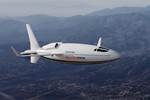ZeroAvia receives CAA approval for next phase of hydrogen-electric test flights
ZeroAvia closed off 2022 by securing Part 21 permit to fly for retrofitted Dornier 228, following successful ground testing campaign.
The U.K.’s Civil Aviation Authority (CAA, London) has granted a permit to fly for ZeroAvia’s (Kemble, U.K.) Dornier 228 aircraft, which has been retrofitted with the company’s prototype hydrogen-electric powertrain. ZeroAvia secured the permit to fly following an extensive ground testing campaign and a rigorous review of the full development program.
As a result of this approval, ZeroAvia can now begin the first test flights of its 600-kilowatt hydrogen-electric powertrain. The 19-seat twin-engine aircraft has been retrofitted in an engineering testbed configuration to incorporate ZeroAvia’s hydrogen-electric engine powering the propellor on its left wing, operating alongside a single Honeywell (Charlotte, N.C., U.S.) TPE-331 stock engine on the right for appropriate redundancy to enable safe testing of the novel propulsion technology.
The test flights are set to be a landmark achievement for ZeroAvia and the HyFlyer II project, an R&D program backed by the U.K. Government’s ATI Programme, which targets the development of a 600-kilowatt hydrogen-electric powertrain for nine- to 19-seat aircraft.
For this testing program, ZeroAvia says it has worked with the CAA to meet a far more stringent set of requirements when compared to the E-Conditions framework ZeroAvia had used for its six-seat prototype in 2020. Part 21 is an industry-standard term used to describe the regulatory approval of aircraft design and production organizations, and the certification of products, parts and appliances for aircraft.
“Earning our full Part 21 permit to fly with the CAA is a critical milestone as we develop a zero-emission aviation propulsion system that will be the most environmental and economical solution to the industry’s climate impact,” Val Miftakhov, founder and CEO of ZeroAvia, says. “We’re going to be starting 2023 in the best way possible, by demonstrating through flight that true zero-emission commercial flight is much closer than many think.”
It will pave the way for a commercially certifiable configuration for ZA600 to be submitted by the end of 2023, ahead of delivering powertrains for the first commercial routes for nine- to 19-seat aircraft to commence by 2025. With 1,500 engines under pre-order, partnerships with seven aircraft manufacturers and multiple fuel and airport partnerships, ZeroAvia believes it is well positioned to lead the industry’s transformation to a clean future.
When test flights begin in January, ZeroAvia’s Dornier 228 testbed is expected to become the largest aircraft to ever fly using a hydrogen-electric powertrain.
Learn more about the company’s partnerships, certification goals and advancement to use of composite hydrogen storage tanks, “ZeroAvia advances to certify ZA600 in 2025, launch ZA2000 with liquid hydrogen in 2027.”
Related Content
-
Plant tour: Middle River Aerostructure Systems, Baltimore, Md., U.S.
The historic Martin Aircraft factory is advancing digitized automation for more sustainable production of composite aerostructures.
-
Manufacturing the MFFD thermoplastic composite fuselage
Demonstrator’s upper, lower shells and assembly prove materials and new processes for lighter, cheaper and more sustainable high-rate future aircraft.
-
Combining multifunctional thermoplastic composites, additive manufacturing for next-gen airframe structures
The DOMMINIO project combines AFP with 3D printed gyroid cores, embedded SHM sensors and smart materials for induction-driven disassembly of parts at end of life.

















